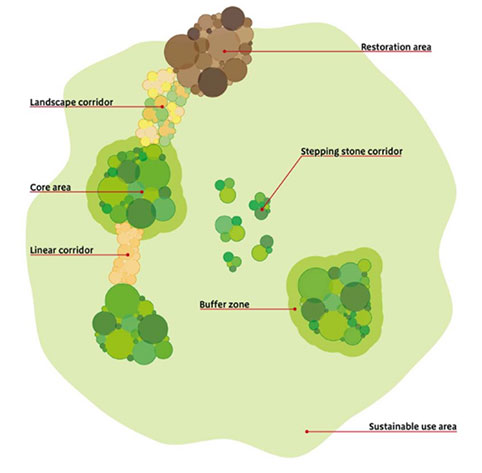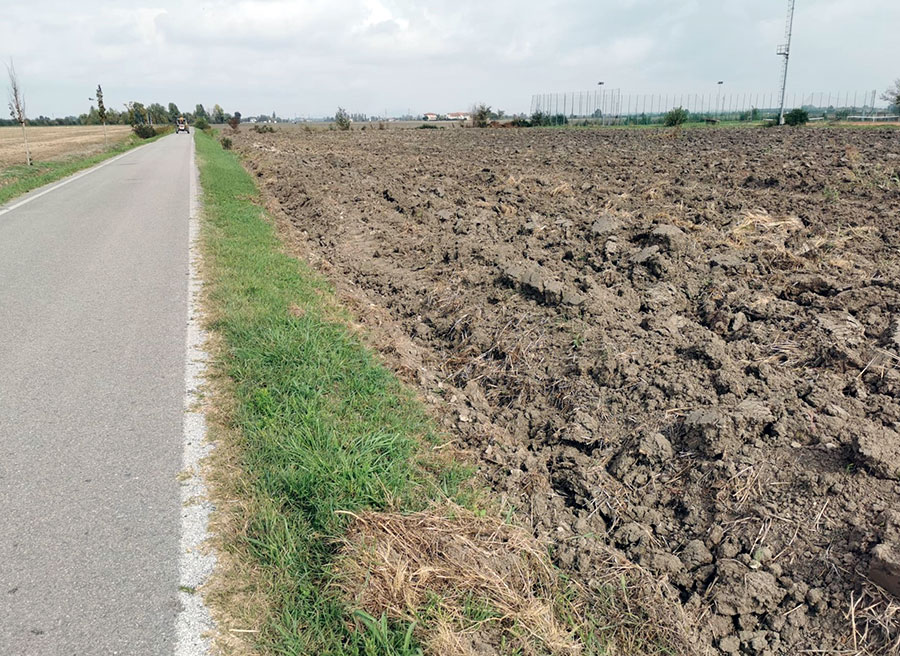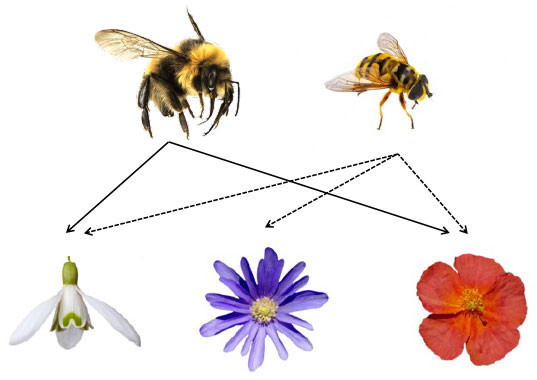Glossary
Actinomorphic or radial symmetry
With multiple planes of symmetry, so that each line drawn through the center gives two mirror-image halves, is usually applied to flowers. Actinomorphic flowers, also called regular, are those of the peach tree or roses.
——–
Alien species
Species that, through the deliberate or accidental action of humans, successfully establishes itself in an area other than that of its original distribution. Within the group of alien species, we can distinguish the category of invasive alien species, that is, alien species which, thanks to their adaptability and reproductive capacity, can spread widely in the newly established area to the detriment of native species. Invasive species are considered one of the major threats to biodiversity as they can lead to the extinction of native plants and animals, and permanently alter habitats. About 10,000 alien species have been registered in Europe, causing damage worth billions of Euros to the European economy every year. In 2014, the European Union adopted a new Regulation on Invasive Alien Species (European Regulation No 1143/2014; EU, 2014), which aims at preventing invasions; minimizing and/or mitigating the detrimental impact of invasive alien species on biodiversity and ecosystem services, economy, and human health; and finally, at establishing early warning and possibly rapid eradication procedures.
——–
Biodiversity
The term biodiversity or “biological diversity” refers to the variety of life on Earth at all its levels, the different plants, animals and microorganisms, the genetic information they contain and the ecosystems they form. Biodiversity also encompasses all the evolutionary, ecological, and cultural processes that sustain life. It includes not only species we consider rare, threatened, or endangered but every living thing, often unknown such as microbes, fungi, and invertebrates.
Biodiversity is usually explored at three levels.
- Genetic diversity is the variety of genes existing in the living world. The genetic variability contributes to the multiplicity of life forms; if we lose one species, we lose a substantial genetic resource.
- Species diversity describes the variety of living species within a habitat or a region. There are millions of living species on Earth. They’re all different and grouped according to their characteristics and peculiarities (plants, insects, animals, fungi, etc.).
- Ecosystem diversity is the variety of ecosystems in a given place. An ecosystem is a community of organisms and their physical environment interacting together. There are different ecosystems on Earth, each with their peculiarities like deserts, oceans, lakes, forests or grasslands. An ecosystem can be as large as a whole forest, or as small as a pond.
Biodiversity on Earth is vital to human well-being, but many species are threatened with extinction due to human activities, endangering human wellness (see Biodiversity Loss).
——–
Biodiversity Loss
The term ” biodiversity loss” refers to the decline in the number of species, their genetic variability and the diversity of the biological communities they form in a given area. This loss can lead to the loss of functioning of the ecosystems in which the decline has occurred and as a consequence to the loss of ecosystem services they provide.
Biodiversity loss can be due to natural disturbances such as fires, floods and volcanic eruptions that drastically alter ecosystems. However, these natural disturbances are temporary, and ecosystems have adapted.
In contrast, the loss of biodiversity caused by human intervention is usually more severe and longer lasting. Humans, their crops, and livestock occupy ever larger areas. Half of the world’s living surface (about 51 million square kilometers) has been converted to agricultural land, reducing the space for wild animals and plants. This massive conversion of forests, wetlands, grasslands and other terrestrial ecosystems has led to an average 60% decline in the number of vertebrates worldwide. Researchers estimate that the current rate of species loss is between 100 and 10,000 times the natural rate of extinction. The 2019 report of the Intergovernmental Science-Policy Platform on Biodiversity and Ecosystem Services (https://ipbes.net/global-assessment) shows that up to one million plant and animal species are at risk of extinction due to human activities.
Coevolution
Coevolution is the process of joint evolution of two species that interact so closely that they influence each other and evolve together. Pollination is an extreme example of coevolution; plants develop structures and strategies for attracting specific pollinators, while pollinators evolve body parts and behaviors suitable to promote pollination of specific plants.
——–
Connectivity
In ecology, connectivity can be defined as the degree of connection between the different natural and seminatural habitats present within a landscape, in terms of their components (types), spatial distribution and ecological functions.
Ecological connectivity is an essential part of nature. Connectivity conservation (through the conservation, enhancement, or the creation of corridors between habitats) is a direct response to the destruction and fragmentation of natural and semi-natural habitats and loss of species. It is a key tool for ensuring the possibility for wild species to move across the landscape; it is crucial to ensuring genetic diversity, for the safeguard and management of habitats, biodiversity and ecosystem functions such as nutrient cycling, pollination, seed dispersal, food security, climate resilience and disease resistance.
——–
Ecological network
An Ecological Network is a system of natural areas connected by ecological corridors, created to conserve biological diversity, particularly in fragmented landscapes. Main components of an ecological network include:
Core areas: areas of high-quality habitat that are managed primarily for biodiversity conservation. which are already, or may be, subject to protection (parks or reserves). Core areas form the ‘nodes’ in the ecological network.
Buffer zones: transitional areas located around the core areas, with a land use that is intended to reduce the impact of neighboring areas.
Linear corridors: linear elements, of various shape and size, that connect core areas. They represent key elements of ecological networks as they allow the movement of species and genetic exchange, a crucial process for the maintenance of biodiversity.
Stepping stones: or stepping stone corridors are smaller areas of high quality that, due to their strategic location or their habitat composition, are intended to aid movement of individuals by serving as ‘islands’ of favourable habitat in between larger core nature areas (e.g., small ponds in an agricultural landscape or flower strips at field edge).
Restoration areas: are degraded areas where management is focused on restoring habitat that might become core nature areas or corridors.

Tipiche component della rete ecologica/The typical component of a terrestrial ecological network. Source: Lawton et al.,2010
Lawton, J. H., Brotherton, … Wynne, G. R. 2010. Making space for nature: A review of England’s wildlife Sites and ecological network. Report to Defra, 107.
——–
Ecosystem services (ES)
Ecosystem services are the totality of services that ecosystems provide directly or indirectly and free of charge to humans. ES can be divided into:
Provisioning services are the products directly obtained from ecosystems (e.g., food, fiber, timber);
Regulating services are the benefits obtained from the regulation of ecosystem processes (e.g., pollination, climate regulation, water regulation, pest and disease regulation);
Supporting services are indirect services, as they are necessary for the production of provisioning, regulating or cultural services (e.g., soil formation, nutrient cycling, photosynthesis);
Cultural services are nonmaterial benefits people obtain from ecosystems (e.g., aesthetic values, recreation and ecotourism, cultural diversity).
——–
Ex ante
Before an action takes place. For example, “ex ante monitoring” is monitoring that is carried out on a site before the implementation of a concrete recovery action.
——–
Ex post
After an action takes place. For example, “ex post monitoring” is monitoring that is carried out on a site after the implementation of a concrete recovery action to verify its effectiveness.
——–
Fragmentation
Environmental fragmentation or fragmentation of habitats is a process, usually of anthropic origin, which leads to the subdivision of a natural environment into fragments more or less disjointed from each other, reducing its original surface. A simple example is the construction of a road through a woodland. For much of the wild species that live in the wood, the road is an obstacle that can only be crossed with difficulty, or not at all. A barrier has been created that effectively divides the wood: what was once one habitat has become two smaller habitats. The main consequences of fragmentation are the disappearance and/or reduction in surface of habitats, their isolation, the creation and increase in surface area of ecosystem types of anthropic origin (matrix), increase in the disturbance of residual habitats (edge effect) induced by the anthropic matrix that separates the fragments. The disappearance of habitats and the fragmentation of residual ones are one of the main threats to biodiversity.
——–
Germplasm
Germplasm is the material capable of transmitting hereditary traits from one generation to the next. It consists of tissues or cells capable of recreating an entire organism and represents the genetic variability available for a specific population. As for plants, germplasm is represented by spores, pollen, tissues, or parts of plants and in particular seeds, which represent the typical structure used by higher plants to produce new individuals.
——–
Habitat
A habitat is the environment in which individuals of a certain species, plants, animals, or other organisms, live, find food, water, shelter and space to survive.
Habitats consist of both biotic (species and biological communities) and abiotic factors (environmental conditions in terms of e.g., temperature, humidity, climate, soil, light intensity).
In natural habitats, species and biological communities are governed by abiotic factors and the interactions between species. In so-called semi-natural habitats (such as areas of traditional agriculture, woods, grasslands, etc.), the species and biological communities present are the result of the interaction between abiotic factors and human management activities. In other words, they are habitats whose conservation depends on traditional rural activities, such as grassland mowing, thus recognizing the fundamental role of humans in the conservation of biodiversity.
——–
Hedonic pricing
It is a method of estimating the value of a good or service based on the market value of the goods in which it is incorporated or which are affected by it. For instance, by comparing the value of houses in a healthy neighborhood with houses in a polluted area, it is possible, all other things being equal, to quantify the “cost” of air pollution in terms of the loss of value of the houses in the polluted area or, conversely, the “price” of health in terms of the increase in value of the houses in the healthy neighborhood.
——–
Landscape heterogeneity
Landscape heterogeneity is defined as the number and proportion of different land cover types (natural such as forests, grasslands, wetlands; compositional heterogeneity) and their complex spatial arrangement (configurational heterogeneity) in the landscape. Compositional heterogeneity regards the diversity of habitat types present in a given portion of land; while configurational heterogeneity encompasses the number, size and arrangement of habitat patches.
Human-dominated landscapes are characterized by complex mosaics, consisting of urban, agricultural, and semi-natural habitats with differing levels of land-use intensity. Increased levels of land-use intensity (urban and rural environment) have well established negative effects on diversity and species composition, as have decreased levels of landscape heterogeneity (reduction and loss of the natural and semi-natural patches). Conversely, landscape heterogeneity can mitigate the negative effects of local land-use intensity: thanks to the variety of habitats present, a heterogeneous landscape can host a larger pool of species, guaranteeing them the necessary resources, shelter sites and the possibility of movement.
——–
Marginal areas
Marginal lands are areas where biophysical and/or socio-economic constraints make cultivation of food or feed crops economically unprofitable. Marginal lands also include underproductive areas, field and road edges, and abandoned areas.

——–
Mutualistic relationship
It is the close relationship that exists between two living organisms and from which both benefit. Plants and their pollinators form a mutualistic relationship. In the plant-pollinator relationship, the pollinator benefits by feeding on food rewards provided by the plant, primarily nectar and pollen. In return, the plant benefits as the pollinator moves from flower to flower, transferring pollen as it forages for the food rewards. This movement of pollen allows the plant to reproduce and to exchange genetic information with other plants. Most flowering plants require relationships with pollinators to reproduce.
——–
Native
Organism that occurs in its natural range; synonyms are indigenous or native. Its opposite is “allochthonous” or, using a more current term, “alien”.
——–
Organoleptic value
The organoleptic value is the value of a food as determined by its chemical properties, such as taste, odour or colour, and its physical properties, such as consistency or size, as perceived by the sensory organs of consumers, in relation to the complex of reactions they evoke in them.
——–
Payments for ecosystem services (PES)
PES is an increasingly common strategy to address the loss and degradation of ecosystem services (ES). Under PES, the beneficiaries of an ES (buyers) pay the providers of services (sellers) to ensure its continuation or enhancement. In this way, the sellers, represented in the project by e.g., farmers, receive compensation for carrying out activities, that are burdensome for them, that aim at properly managing agroecosystems, or at modifying/suspending activities that may negatively affect an agroecosystem (e.g. farmers may be paid for delaying the mowing of meadows to ensure the flowering of plant species visited by pollinating insects and thus receive economic compensation for the reduced amount of hay they can obtain).
——–
Pheromone
Is a chemical substance released by an animal that influences the behaviour of another animal of the same type, for example by attracting it sexually
——–
Pollinating insects
Pollinating insects are those insects that carry pollen from one flower to another, allowing pollination and subsequent reproduction of entomophilous species. . Accordingly, we can define as entomophilous, a lant species pollinated by insects
——–
Pollination network
A pollination network describes the type of interactions establishing between plants and pollinators. In a pollination network, plants and pollinators are the nodes, while the interactions for pollination form the links between these nodes The pollination network is defined as ‘bipartite’ since interactions only exist between two distinct, non-overlapping sets of species, i.e., interactions cannot exist within the set: a pollinator can never be pollinated, unlike in a predator-prey network where a predator can be depredated. A pollination network is also defined as ‘two-modal’, i.e., it includes only links connecting plant and animal communities.

——–
Pollination syndrome
Convergence of floral traits of different species in response to selection pressure by pollinating agents. According to the theory of the pollination syndrome, species with similar floral traits are pollinated by the same pollination vector.
Stakeholder
Stakeholder is a natural person or legal person who is directly or indirectly involved in a project or activity.
——–
Trait
Characteristic that is measurable at the level of a single individual, from the cellular level to the level of the whole organism, and that relates to morphological, physiological and phenological features.
——–
Vertebrates
All animals that have a spine, namely: fish, amphibians, reptiles, birds, and mammals.
——–
Zygomorphic or bilateral symmetry
With a single plane of symmetry, so that only one line drawn through the center gives two mirror-image halves, is usually applied to flowers. Zygomorphic flowers, also called irregular, are those of wisteria or rosemary.

